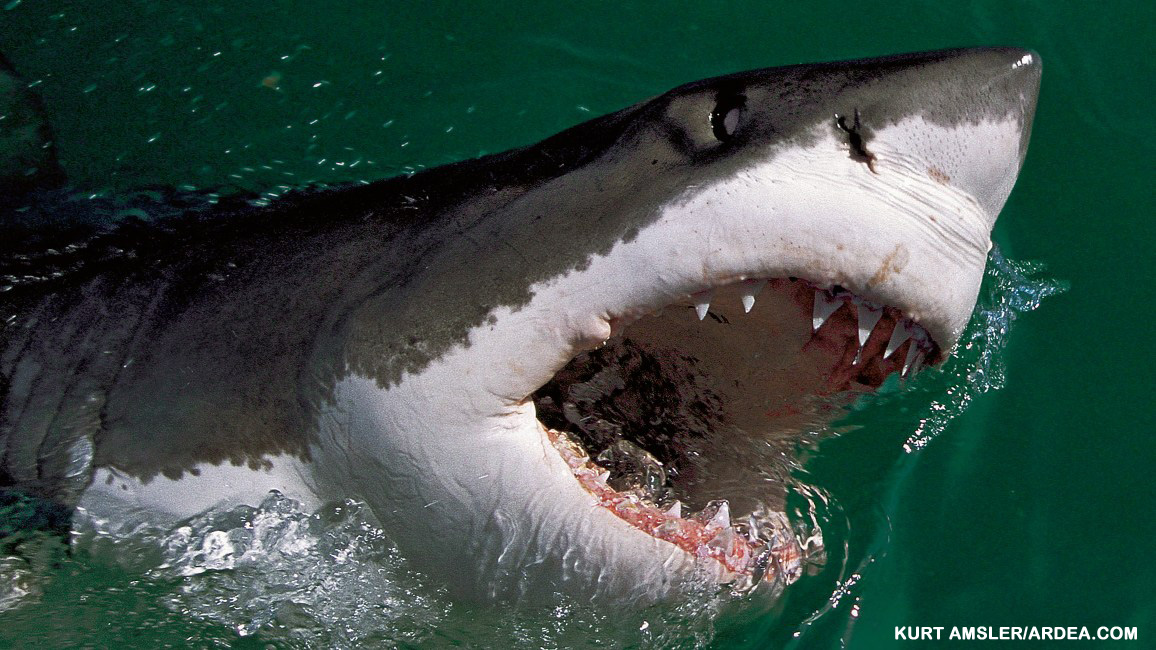
Sharks
By Kathy KrankingSink your teeth into some facts about these toothy fish.
You probably recognize the great white shark (above), one of the most famous shark species of all. And you know that, like many other sharks, they’re expert predators. But what else do you really know about sharks?
These toothy fish have a reputation for being scary. Even so, there are more than 440 species of sharks, and less than one percent of those species are dangerous to people.
Sharks live in oceans all over the world. Some kinds live close to the surface, some in deeper waters, and some near the ocean floor. No matter what part of the ocean they’re found in, sharks have been swimming there for a long time—since way before dinosaurs existed. Scientists have found fossilized shark teeth that are more than 400 million years old!
ASSORTED SHARKS
Sharks come in different shapes and sizes. They can be bigger than a bus or only a little longer than your hand. And though many are the familiar torpedo shape, some can look quite different (more on that later).
The biggest shark—and the biggest of all fish—is the whale shark. Despite its huge size, this gentle giant eats tiny animals called plankton. As it swims along with its mouth open, the plankton get swept inside. The water goes back out through the shark’s gills, while the plankton continue to the back of the shark’s mouth. Then the shark swallows its meal. (Watch a whale shark video here.)
BUILT TO BITE
Most sharks, though, hunt down and eat other animals. And they have everything they need to be amazing predators. Take their teeth, for instance. Most toothed animals have just one set of teeth for their whole lives. But sharks have many rows of teeth. As old teeth wear out or break, new ones keep moving up to replace them. A shark may grow thousands of teeth during its lifetime!
The shape of a shark’s teeth depends on what kind of prey it catches. Teeth with saw-like edges are used for cutting and tearing large prey such as fish. Long, curved teeth are great for catching slippery prey such as squid. And flat teeth crunch up crabs and other shellfish.
SUPER SENSES
Sharks have excellent senses that help make them great predators. One of the best is their sense of smell. They can smell things that a person never could! Smelling is the only job a shark’s nostrils have—sharks do their breathing through gills. Tiny pores, or openings, on a shark’s snout help it with another sense. They pick up electrical signals from prey. (All living things give off small amounts of electricity.)
Like other fish, a shark also has something called a lateral line along each side of its body. This is a line of pores that are sensitive to vibrations. A shark can use its lateral line to detect movements of prey.
ANGELS AND NURSES
Not all sharks are typical. For example, as mentioned earlier, they aren’t always “shark shaped.” Sharks that live on the ocean floor, such as angel sharks, have flat bodies. This helps them hide, buried in the sand, as they wait for prey to come near.
And sharks don’t always swim around, either. A nurse shark spends most of its time resting on the ocean bottom. It can use its fins to prop itself up or even “walk” forward or backward!
THE START OF A SHARK
Most sharks give birth to their young. But some kinds lay eggs. Either way, sharks don’t stick around to take care of their babies. When a baby shark comes out, it just swims off on its own, able to take care of itself.
A shark egg case is a little leathery bag, often called a “mermaid’s purse.” The case has a yolk sac inside it, which keeps the baby shark fed. By the time the yolk sac is used up, the baby has grown big enough to push its way out of the egg case. Then off it swims, ready for life on its own.
And now you know more than a mouthful about sharks!
“Sharks” originally appeared in the June/July 2015 issue of Ranger Rick magazine.
(Click on each image above for a closer view of the story.)



















